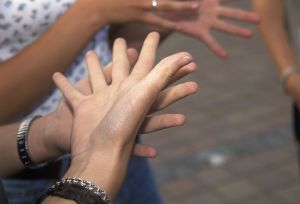[ad_1]
Contributed by Debbie Clason, staff writer, Healthy Hearing
Last updated
Members of the Deaf community in America use a different language—literally. Not only does their language—American Sign Language (ASL)—connect them to others who are Deaf, it also serves as a membership card into a linguistic subculture of our society that not everyone is privileged to enjoy.
Breaking down stigmas

verbal.
One of the ways the Deaf distinguish themselves as a culture is by capitalizing the word Deaf and working to change mainstream America’s attitude. The Deaf culture doesn’t believe in using the word “disabled” because that word makes implies “less than”—as though they are lacking something. By removing the label, they are also removing any stigma that might be attached.
“It’s about perspective,” Deaf advocate Eileen O’Banion said. “When you are Deaf, you see the world in a different way. You communicate differently. You seek out others who are Deaf because they understand you. You don’t believe you have a disability—and you don’t want to be fixed.”
In fact, some advocates even speak about “Deaf gain,” a communication advantage afforded to those who must use means other than verbal language. The idea is that deaf people have more meaningful and intentional connection because they cannot hear.
Tough choices around cochlear implants
Meghan Watt lost her hearing after contracting HIB meningitis at the age of two. A conversation with a middle high school teacher piqued her interest in cochlear implant (CI) surgery, even though she admits she wasn’t always keen on the idea. Today, she has bilateral cochlear implants.
Meghan is aware there is controversy among certain factions of the Deaf community regarding cochlear implants and is comfortable with the choices she’s made. “Some don’t approve of CIs and that’s that,” she explained matter-of-factly. “If they’re happy being Deaf, that’s great. That’s their decision. I like being able to hear what’s going on around me.”
Some members of the Deaf community are opposed to cochlear implant surgery—especially for infants who are born without hearing. They believe every person deserves the right to choose for themselves whether they want to remain Deaf and encourage parents to begin teaching ASL as the baby’s first language. Some activists believe learning language and cognitive development through ASL is a basic human right that should be protected and that choosing cochlear implants steers families away from learning ASL and embracing Deaf culture.
Audism and oralism
Nine out of 10 Deaf infants are born to hearing parents. Many of those parents choose cochlear implant surgery as soon as they are medically able because it helps their child with speech development.
But the Deaf culture believes mainstream hearing America puts too much emphasis on the spoken word. They maintain ASL is a complete language, even though they don’t produce words with their mouths and voices.
Some activists talk about audism—an attitude of superiority based on an ability to hear—and oralism—advocacy or use of the oral method of teaching Deaf students to speak. Audism and oralism, activists maintain, degrade ASL and interfere with the Deaf person’s ability to develop speech and listening skills.
“Deaf culture is important because it allows individuals to be who they are,” O’Banion explained, “and live in a way that is unique to them. There’s more to a person than whether or not they can hear, so don’t just focus on their ears.”
American Sign Language (ASL)
According to the National Institute on Deafness and Other Communication Disorders (NIDCD), ASL is a complete, complex language consisting of signs made by the hands, facial expressions and body language. The National Association of the Deaf (NAD) calls ASL the “backbone of the American Deaf culture.”
“Many who are not familiar with ASL think it’s English and hand gestures,” O’Banion said. “It’s not. Signing is different between countries and regions, much like the spoken word is different between countries and regions.”
While the origins of sign language are not clear, most agree that it began almost 200 years ago and has been evolving ever since. Like modern language, sign language has different accents, rhythms, rules for pronunciation, word order and grammar. The language is so complex, some members of Deaf culture say they can identify when a person learned ASL simply by observing the way they sign.
How to communicate with a Deaf person
Fortunately, you don’t need to know ASL in order to communicate with a Deaf person. According to a tip sheet developed by the Rochester Institute of Technology, one of the country’s premiere learning institutions for the Deaf, there are five guidelines to remember when communicating with the Deaf.
- Acknowledge the fact that your first attempts to communicate will feel awkward and uncomfortable. This will pass as your interaction progresses.
- It’s OK to use paper and pen. In fact, the Deaf person will appreciate your efforts even more if you use a combination of communication methods, such as hand gestures, facial expressions and the written word.
- Take the time to communicate and connect. Deaf people consider communication an investment of time and effort. Slow down, take your time and ask for clarification if you need it.
- Understand that Deaf people listen with their eyes. Vision is the most useful tool they have to communicate and receive information. For this reason, only speak when you have eye contact, even if they are using an interpreter. Maintaining eye contact is a sign of respect.
- Use the beginning and ending of a conversation as an opportunity to make physical and visual contact with the Deaf person, especially if they have been using an interpreter during your conversation. Smile, shake hands, touch their arm (if appropriate) and make eye contact.
[ad_2]
Source link

